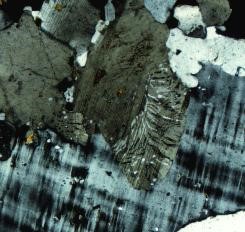
Before completing the Ph.D., I married Barbara Schenck, a student I met in one of our geology classes, and we spent two years together in Germany where I was an intelligence officer for the U. S. Air Force, before we returned to school. After graduating from the University of Illinois, I accepted a teaching position at San Fernando Valley State College, which subsequently became California State University Northridge. I taught mineralogy, petrology, and photo-geology interpretation for 33 years there before retiring from teaching in September, 1993.
In 1972, I noted that myrmekite occurred in unusual outcrops near Temecula, California, under conditions that did not fit the standard explanations for its origin, and I began investigations of this unusual two-mineral intergrowth (Fig 1). I never suspected that the study of myrmekite would lead to such opposition by the geologic community to the hypotheses that I have developed about its origin. Electron-microprobe analyses, cathodoluminescent studies, field relationships, scanning-electron images, and thin section studies convinced me that myrmekite had an origin entirely different from that generally believed by most geologists. Rejection of nearly all papers submitted to refereed journals caused me to publish in two books and to use this web site for announcing additional results.

Fig. 1.Wartlike myrmekite (center) with tiny quartz vermicules from Temecula, California. Plagioclase in the myrmekite is optically continuous with quartz-free, albite-twinned plagioclase (tan, top). The myrmekite projects into K-feldspar (microcline, black-gray-white, grid-twinning, bottom).
A photo of what I looked like in my younger years, when I had bright red hair, can be seen in the January, 1966, issue of National Geographic magazine in the article: "Finding Rare Beauty In Common Rocks."
My wife, Barbara, kept me honest and was wonderful support while she was living. She passed away April 28, 2013. I give her credit for the editing of these web-site presentations, helping to make the arguments reasonable and having greater logic than I could accomplish. She and I have a website which has more than 1,600 color photographs of trees, shrubs, and wildflowers of the deserts and chaparral of southern California. The plants are all indexed by common, scientific, and family names. See: https://earth.callutheran.edu/Academic_Programs/Departments/Biology/Wildflowers (wildflowers). On this site are links to four other sites that include garden flowers, the Canadian Rockies, Holden Village plants, and the CLU campus arboretum, These added websites bring the total images to more than 10,000.
We have five children whose accomplishments are varied and meritorious, but which are for them to brag about.
There is a Wikipedia article about me dealing with my life, research, and articles that demonstrate how some kinds of granite can be formed by chemical replacement processes as well as other articles that are written in opposition to the views about young-Earth creationism. More than 300 geologists have been described on Wiki and 100 of these are still living. I am among the living. Unfortunately, this article is no longer on the English Wikipedia website, but it can be viewed on the German Wikipedia website by doing a Google search for Lorence G. Collins Wikipedia auf deutsch. Once viewed, you can direct your computer to translate the article into English.
Dr. Lorence G. Collins Department of Geological Sciences California State University Northridge 18111 Nordhoff Street Northridge, California 91330-8266 FAX 818-677-2820